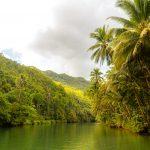
How to get started in swimcamping
If you love swimming and camping, expand your swim horizons with an overnight adventure and go swimcamping, says Colin MacLeod
What is swimcamping? In a nutshell, swimcamping is swimming with your camping kit, and then camping! Swimcamping can be anything from swimming (while towing your kit) to an island for an overnight stay to heading downstream on a river and camping at a suitable spot or walking out to a lake then pitching up and having a dook there. Also, you could plan a multi-day trip with swimming and camping en route to a destination, which might involve youth hostels, campsites or wild camping. It’s your adventure, pack and plan for it and you’ll have an amazing experience.
- Read our guide to the best tow floats for wild swimming
How do I swim with my camping gear?
You have two main options as methods of swimming with your camping gear: a large waterproof rucksack or a RuckRaft, both of which you tow behind you as you swim. A RuckRaft is a small inflatable raft and large drybag in which you can transport your own rucksack.
A waterproof rucksack is essentially a large drybag with straps (Lomo or North Coast Wetsuits make good ones) that is buoyant enough to tow behind you as you swim and when you get to land you just unclip it from the leash, hoist it onto your back and you’re ready to hike. The Ruckraft has the advantage of being more aquadynamic and gives you the benefit of being able to hike with a proper rucksack on the walking sections of your adventure. A waterproof rucksack is a cheaper option but not as comfortable as a rucksack designed for hiking.



How much kit can I take with me?
Whichever option you choose, if you pack sensibly you will be able to swim with enough kit for multi-day adventures. A RuckRaft will support a full 70l, 15kg expedition pack. A 60l waterproof rucksack will allow you to swim with 15kg of kit.
How do I get started?
If you already have camping and swimming gear, it really can be quite an inexpensive pastime to get into. A good knowledge of navigation and map reading is essential for route planning. If your route involves sea swimming pay attention to tides and currents and plan your route and time of swim accordingly. Local knowledge is always helpful.

Where am I allowed to camp?
I am lucky to live in Scotland where we have the right to roam; please check and follow what your own country’s guidelines are. We need to respect our countryside, so we leave no trace and pack out everything you take in. Wild camping is not officially allowed in England apart from on Dartmoor, so if you choose to wild camp please do so responsibly.


#spreadthewordnottheweed
Invasive non-native species of wildlife can hitchhike on bodies, body hair, equipment, footwear, clothing and boats. It is good practice to clean, rinse and dry clothing and equipment when going from one body of water to another wherever you are to avoid carrying non-native species about with you. But, in particularly sensitive regions such as the Lake District, it is critical. If you are planning a swimcamping adventure in the Lake District where you are travelling between lakes, always check and clean your equipment after each swim (eg, at a camp site) and consider the order in which you travel. Go from the cleanest lakes, rivers and tarns first.
Why I do it and why I love it
Having swum to a lot of places around where I live in the Outer Hebrides, it’s now fantastic to be able to camp over at these locations and take in much more of the beautiful Hebridean scenery. Swimcamping has such a great learning curve, with ideas on how to better my kit, making it more efficient, as well as learning from others and also passing on my own experiences to anyone who is keen to learn. I love the planning side of it – swim routes, map reading, tides, possible hazards, any historical information etc. Believe it or not, swimcamping is not a new pastime as there are people around the world who have been enjoying this exciting adventure for years. Lucky them!

Colin’s top three swimcamping tips
- Your safety is paramount. Let family/friends know where you are going, times of departure and ETA back home. I also use a Spot Gen 3 satellite tracker for people to be able to track me via an online link. It also has SOS and Check In buttons. There’s a variety of different devices available for your personal safety – I have the RYA SafeTrx app on my mobile. Choose to suit your own needs. Remember to keep within your own skillset.
- Glean as much information as possible about your planned route, like currents/tides, landing and camping spots. Speak to people that may have visited the area before as there’s nothing like local knowledge. Plus, has anything changed since you last visited the location? Neap tides and slack water is usually the best times for swimming as there’s less movement of water.
- Practising with your swimcamping kit at home and in water before your first outing is essential. This way, you’ll be used to how it all works, how it feels to carry on land and towing behind you on water. Being at ease with your kit always feels good. I pack my kit into small dry bags for a boots and braces approach. I have a list of my gear, and what goes in each bag inside my waterproof rucksack, which makes it quicker for packing. This list has been evolving over time as I continue to learn, mostly getting lighter and smaller.
Watch Colin’s HebSeaSwimmer YouTube channel. Join the Swimcamping Facebook group. Find out more about RuckRaft on the Above Below website.
This feature was originally published in the June 2021 issue of Outdoor Swimmer. Subscribe to the magazine. Photos: Colin MacLeod, Above Below.








